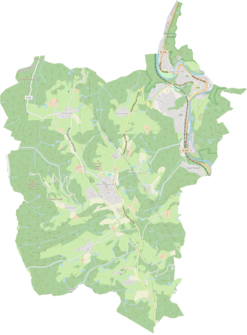Brenscheider mill
|
Brenscheider mill
Community Iserlohn
Coordinates: 51 ° 17 ′ 7 ″ N , 7 ° 36 ′ 12 ″ E
|
||
|---|---|---|
| Height : | 308 m | |
| Postal code : | 58769 | |
| Area code : | 02352 | |
|
Location of Brenscheider Mühle in Nachrodt-Wiblingwerde |
||
|
Brenscheider grain mill
|
||
The Brenscheider Mühle is an old early modern grain mill. The newer Brenscheider oil mill is in the immediate vicinity . The ensemble of the Brenscheider mills is a technical cultural monument and is located in the Nahmertal in the municipality of Nachrodt-Wiblingwerde south of Hohenlimburg on the municipal border with Schalksmühle .
Living space
The living space Brenscheider mill belonged to the 19th century the parish , office , formulation and district court Altena the county of Mark in. From 1816 the place was part of the school district Wiblingwerde of the tax community Wiblingwerde of the rural mayor's office Altena in the Altena district . The place categorized as a mill according to the location and distance table of the government district of Arnsberg had a residential house, a mill building and two agricultural buildings in 1839. At that time there were seven residents living in the village, all of whom were evangelicals.
The municipality and estate district statistics of the province of Westphalia listed the place as a Mahlmühle Bredenscheidermühle with two houses and 23 inhabitants in 1871 . The municipality encyclopedia for the province of Westphalia in 1885 gives a number of 23 residents for Bernscheider Mühle who lived in a residential building. In 1895 the place had two houses with 14 inhabitants, in 1905 two houses and 12 inhabitants are given.
On April 1, 1907, the municipalities of Wiblingwerde and Kelleramt were combined to form the municipality of Nachrodt-Wiblingwerde, which brought Brenscheider Mühle into what is now the municipality.
Grain mill
The hydro-powered grain mill in the Nahmertal was first mentioned in writing in 1593. It was probably built a few years earlier. It was a sovereign ban mill in County Mark . With the change of rule from the Dukes of Kleve , it came to Kurbrandenburg and later to the Kingdom of Prussia . Around 1700 about 800 farmers had their grain ground in the mill. Due to the poor agricultural conditions in the area, the mill's yield remained low.
The mill was operated by water power. For this purpose, a stream was dammed up above, which drove two mill wheels. The sovereigns gave the mill to tenants. For a long time the tenant families changed often. In 1765 the mill to the family Brenscheid was in perpetual lease passed. This managed the mill until 1839, when the mill became private property. It was sold to Johann Diedrich vom Hagen. At the beginning of the 19th century a bakery was built at the mill. It is still owned by this family. The remote mill produced less and less income and was closed in 1952. In the following years the facility and building fell into disrepair. It has been restored since 1975. A new mill wheel was installed and the necessary systems were taken over and installed from a bakery that was no longer in operation. Bread has been baked in the mill since 1984.
The mill is a two-story building with a gable roof . In the older half-timbered part were the two mill wheels. A second part made of quarry stone, added later, served as a bakery. The actual bakery with the oven was added to the gable end . This is operated from inside the mill building. The mill is now a listed building.
Oil mill
The neighboring oil mill at the confluence of the Brenscheider Bach in the Nahmer was built in 1845 by Johann Dietrich von Hagen. This produced oil from rapeseed . The mill is single-story and made of quarry stone masonry. Due to the growing competition for industrially produced oil, it was shut down at the beginning of the 20th century, restarted during the First World War and finally closed in 1923. As a result, the building began to deteriorate. In the 1950s, the first renovations were carried out on a private initiative. The mill became the property of the Altena district in 1958 . It has been a listed building since 1982. As a result, it was renovated by the municipality of Nachrodt-Wiblingwerde and the Märkischer Kreis .
There is a restaurant next to the grain mill. There are several themed hiking trails around the mill ensemble.
Web links
Individual evidence
- ↑ a b Johann Georg von Viebahn : Local and distance table of the government district Arnsberg, arranged according to the existing state division, with details of the earlier areas and offices, the parish and school districts and topographical information. Ritter, Arnsberg 1841.
- ↑ Royal Statistical Bureau Prussia (ed.): The communities and manor districts of the Prussian state and their population . The Province of Westphalia, No. IX . Berlin 1874.
- ↑ Royal Statistical Bureau (Prussia) (ed.): Community encyclopedia for the province of Westphalia, based on the materials of the census of December 1, 1885 and other official sources, (community encyclopedia for the Kingdom of Prussia, Volume X), Berlin 1887.
- ↑ Königliches Statistisches Bureau (Prussia) (Ed.): Community encyclopedia for the province of Westphalia, based on the materials of the census of December 1, 1895 and other official sources, (community encyclopedia for the Kingdom of Prussia, Volume X), Berlin 1897.
- ↑ Königliches Statistisches Bureau (Prussia) (Ed.): Community encyclopedia for the province of Westphalia, based on the materials of the census of December 1, 1905 and other official sources, (community encyclopedia for the Kingdom of Prussia, Volume X), Berlin 1909.



